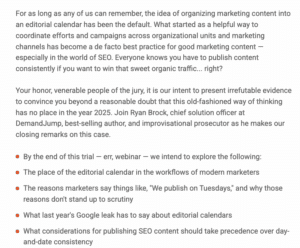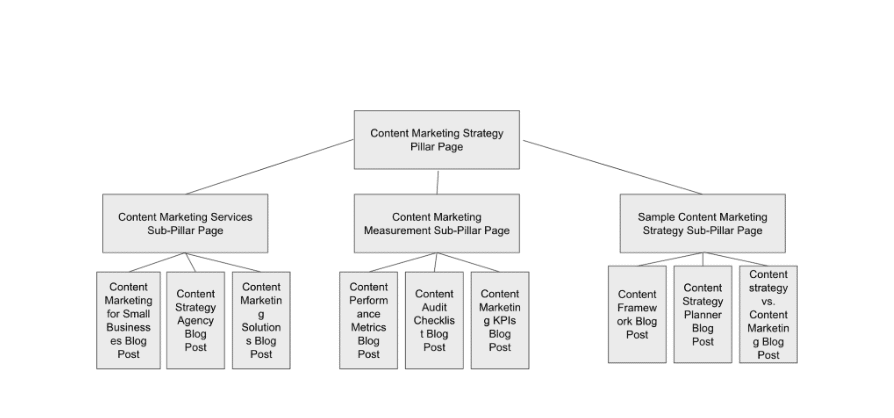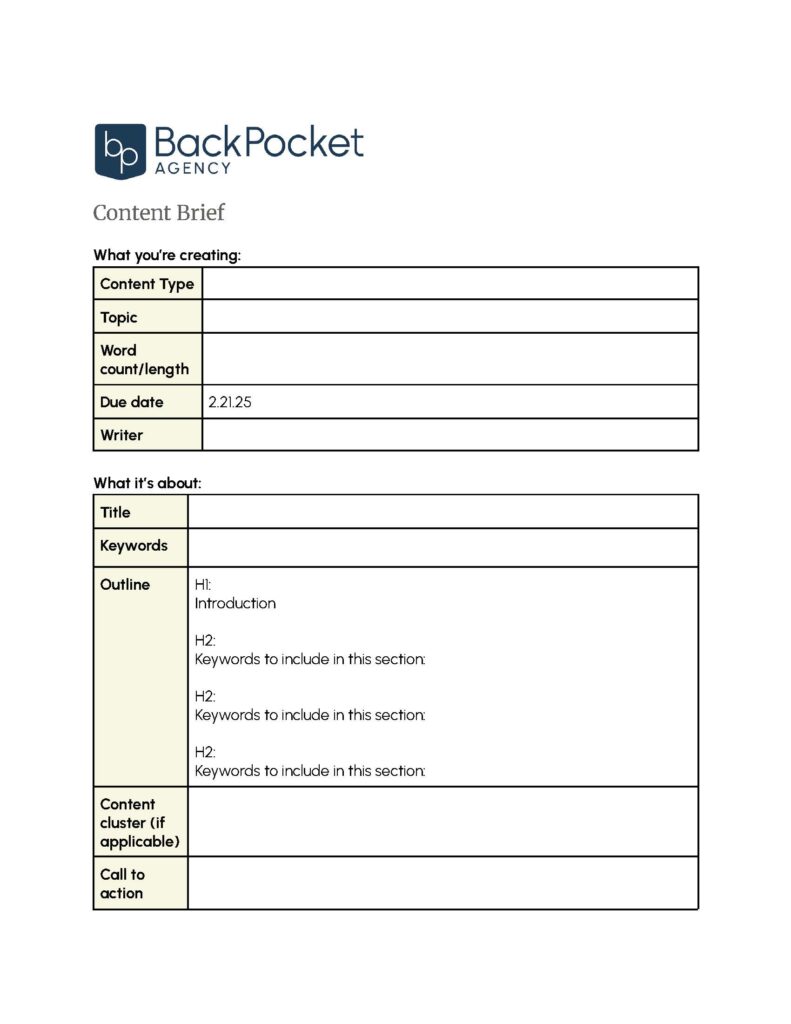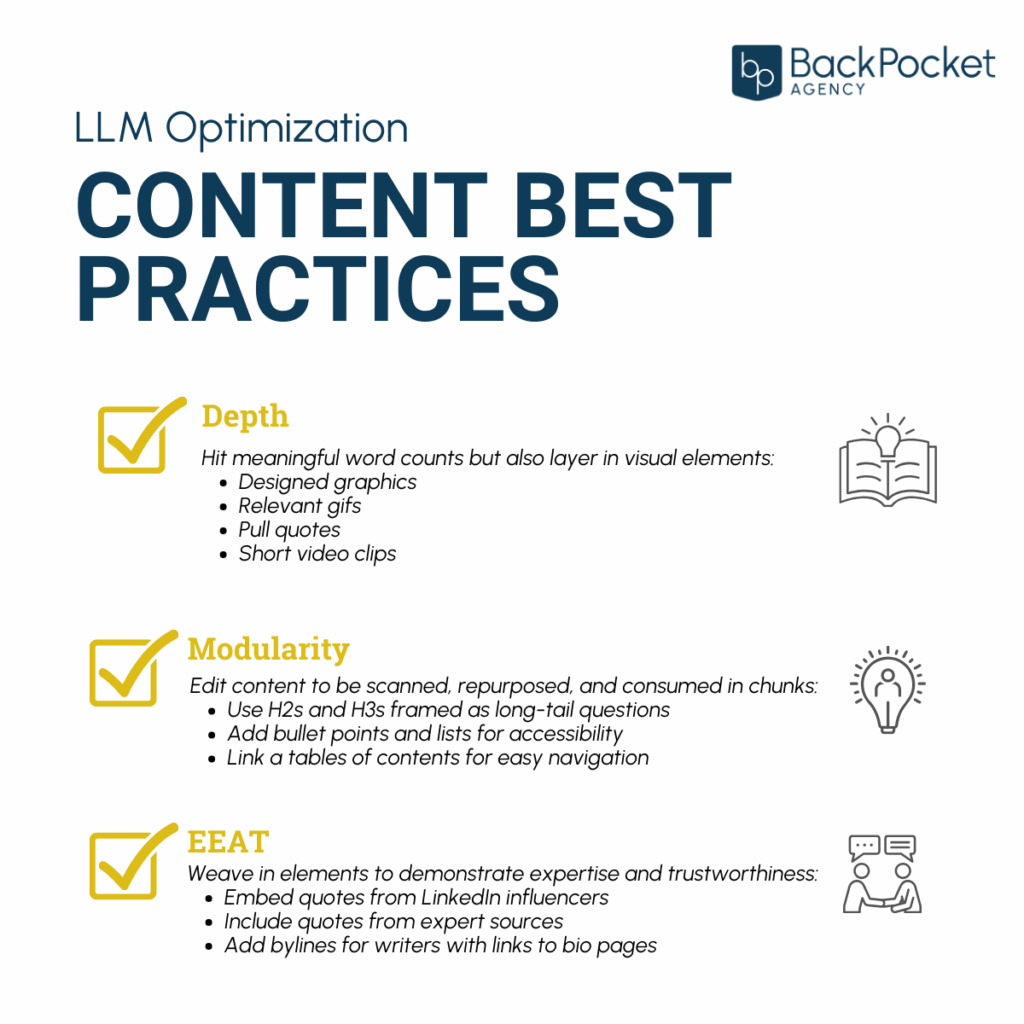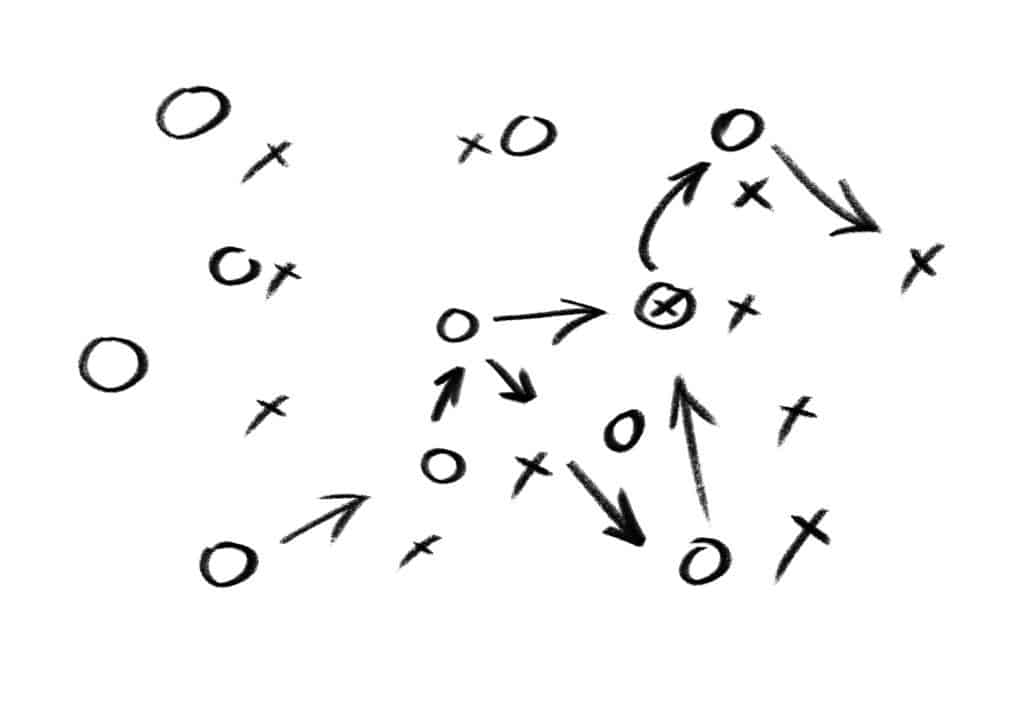How Our Start-up Agency Broke Into AI Overviews Without Paid Tools

Fresh out of San Diego and the 2025 Content Marketing World, one thing was crystal clear to me (and probably everyone who attended): With organic search traffic plummeting for so many brands, marketers are desperate to gain visibility in LLMs.
A few months before that conference, we had cracked a bit of that code on our own and were making plans to scale it.
In a crowded market, our start-up content marketing agency, BackPocket — with a website that wasn’t even a year old — had found our way into AI Overviews for content strategy-related searches along with heavy-hitter brands like Social Media Examiner, Bynder, and the Content Marketing Institute.
It wasn’t a fluke. It was part of a strategy that we kicked off in January 2025, just four months after BackPocket was officially launched.
Stick with me for exactly what we did, how you can do it, and where we’re headed next.
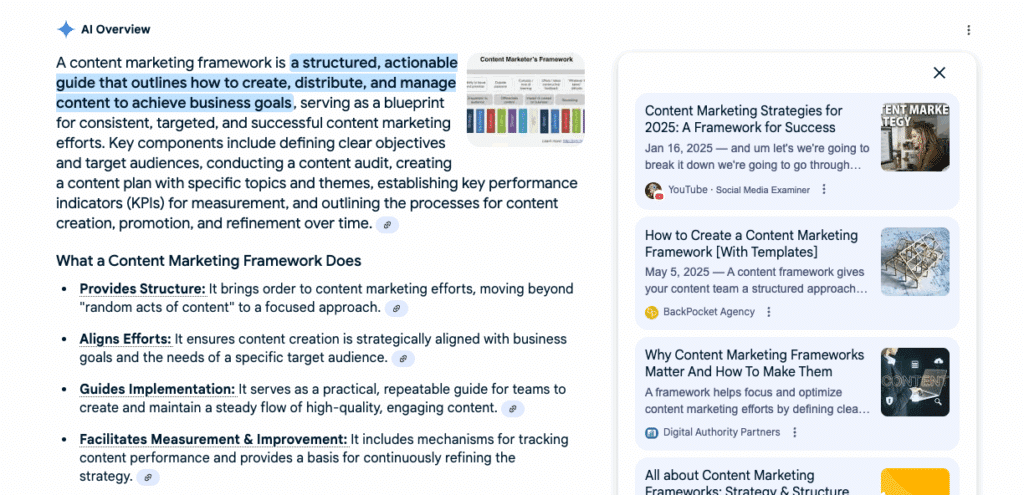
Sample September 2025 search for “content marketing framework” where BackPocket content is referenced the AI Overview.
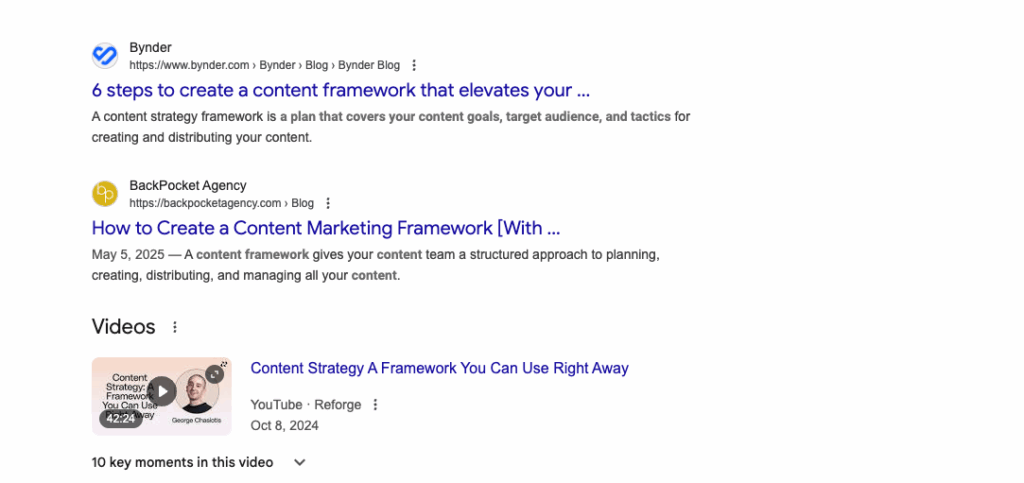
Sample September 2025 search for “content marketing framework” where our content was found on page 1 of the SERP.
The Webinar That Led Me Straight Down the Funnel
In January 2025, BackPocket was a 4-month-old company with a brand-new website, no digital equity, and very little brand awareness.
I was three months into my role as Chief Strategy Officer, and I knew we had a steep hill in front of us in terms of gaining visibility online for our baby brand.
An email from CMI caught my attention. It promoted an upcoming webinar hosted with a catchy title: “The People vs. the Editorial Calendar.” Here’s the description that led me straight to the registration page:
Ryan made some stop-you-in-your-track statements:
- Regularly scheduled blog posts were doing brands no favors.
- Unless a brand had built a blog audience that waited with bated breath for the latest Thursday morning post to be published, toss that strategy out.
- His answer instead was pillar content, a strategy centered around one pillar page as a comprehensive resource on a broad topic. The pillar page serves as a central hub for a group of related pages and blog posts.
- He proposed that the right pillar strategy and execution could move any brand into page 1 SERPs, no matter the brand’s search equity or the competitiveness of the search term.
What I heard: This strategy could give a brand-new agency premium visibility in search.
Convincing Our Leaders That We Should Toss Out the Typical Blog Strategy
Hook, line, sinker. I didn’t waste any time downloading the e-book written by Ryan and DemandJump’s co-founder Christopher Day titled, “Pillar-based Marketing: A Data-driven Methodology for SEO and Content that Actually Works.” (Note, since that webinar, DemandJump was purchased by DemandScience.)
It detailed out their approach to pillar content in an incredibly prescriptive way — with the final chapters promoting their paid keyword research tool as the crucial piece to mapping out your own pillar plan.
Did I mention our business was in true start-up mode? It just wasn’t in our budget yet to invest in pricey tools like theirs.
But my husband, with certainty, would tell you that once I get an idea in my head, you’d be best-served to let my force of nature pass on by.
BackPocket’s co-founders Joe Stella and Rene Ryan have been around content marketing for more than 20 years. And honestly, the pattern was pretty much the same for years: The brands that keep their blogs updated on a regular basis are the ones that really take off.
I laid out my proposal for turning that tried-and-true strategy on its head. They took a big chance, placed a lot of trust in me, and gave me the buy-in I needed to place all our blog chips on this new hand.
Well, I reasoned with myself, if this strategy was full of bologna, at least we’d have a lot of great content to repackage, even if it did nothing to gain us visibility in search.
Laying Out Our Pillar Strategy at a Glance
Before we dive into the details, here’s the high-level blueprint we built everything around:
- Core Focus: One central pillar page on Content Marketing Strategy
- Supporting Structure: Three sub-pillar pages, each backed by three supporting blog posts
- Keyword Approach: Long-tail questions + conversational follow-ups (designed for both Google and LLMs)
- Quality Standards: Every piece written and edited with EEAT best practices, optimized for scalability and authority
- Linking Logic: Clean upward linking structure where every road leads back to the pillar page
- Publishing Cadence: A deliberate batch rollout schedule designed to maximize indexing and momentum — counter to the traditional “one post a week” publishing model
This framework became our playbook. From here, we broke it down step by step, from mapping out keywords, to equipping our writers, to editing for EEAT and depth, and finally, to publishing with precision.
Mapping Our Pillar Through Keyword Research and Intent Analysis
Here’s where things got both scrappy and enlightening. I won’t sugarcoat it: This process would have been infinitely faster with a paid tool like DemandJump or SEMRush. But not having that luxury forced us into the trenches in the best way possible.
Instead of pushing a button and watching a pillar map appear, we had to peel back layers ourselves. We leaned on the free versions of SEMRush, DemandJump, and AnswerThePublic to pull broad keyword lists, then combed through them for patterns. The free versions only take you so far, though. They’ll hand you a laundry list of phrases but not the comprehensive plan you need to build a real strategy.
So we supplemented with manual research:
- We typed long-tail questions directly into Google.
- Then we studied “People Also Ask” results.
- We scrolled to the bottom for related searches.
- Finally, we paid attention to the kinds of conversational follow-ups LLMs were generating.
That combination gave us clarity — not just what people were asking, but also why.
By the time we were done, we had a map of content opportunities that reflected real intent, beyond simply keywords. Because we’d done it by hand, we fully understood the “why” behind every page. That foundational work kept us honest and intentional.
Arming Our Writers With Detailed Content Briefs
Once the strategy was nailed down, we couldn’t just throw it over the fence to our writers and hope for the best. Everyone needed to understand the bigger picture.
So we built detailed content briefs for each page that included:
- Title based on the primary keyword phrase, or long-tail question
- Secondary keywords to use as H2s that were related topics
- Relationship of the page to the other pages
- Directions to include expert commentary, graphics, and data points
- Intended call to action
Then we kicked things off with a team meeting. I walked all our writers through the full strategy — not just their individual assignments, but why this matters and how each piece fits into the whole.
Within those guardrails, we gave writers full creative license to bring their own storytelling style, examples, and voice. That balance between structure and creativity is what made the content feel human, not robotic.
To add credibility, we paired writers with interviews from our senior team, ensuring that expert perspectives were baked right in.
Download our Content Brief template.
Editing Our Content for Depth, Modularity, and EEAT
In our editing phase, we looked at every draft through three lenses:
- Depth
- Modularity
- EEAT (Experience, Expertise, Authoritativeness, and Trustworthiness)
Depth meant no fluff.
Articles hit meaningful word counts but also layered in:
- Designed graphics
- Relevant gifs
- Pull quotes
- Short video clips
Modularity meant scanability.
The content needed to be scanned, repurposed, and consumed in chunks. That editing work included:
- Using H2s and H3s framed as long-tail questions
- Adding bullet points and lists for accessibility
- Linked tables of contents for easy navigation
- Ensuring every piece stood alone but also connected seamlessly upward
EEAT meant standing out from the noise.
We weaved in crucial elements:
- Embedded quotes from LinkedIn influencers
- Quotes from our expert sources
- Bylines for every writer with links to their bio pages
All of this meant that by the time we hit publish, our content wasn’t just ready for search engines or LLMs. It was built to deliver value for our audience through clarity, credibility, and a structure designed to meet them where they’re at.
Specific Upward Linking Structure and Publishing Schedule
I have to be honest: This part felt a little bit like SEO witchcraft. We built an internal linking strategy that was ruthlessly intentional. All links pointed upward, never downward:
- Blog posts linked to their sub-pillar and the main pillar.
- Sub-pillars linked only to the pillar.
- The pillar stood alone at the top, with no outbound links of its own.
Publishing followed the same choreography:
- We launched the pillar page first and watched for it to index on Google Search Console.
- Once it was indexed, we published all three sub-pillars at once.
- Then, after those indexed, we rolled out the supporting blog posts in a single wave.
Once everything was in place, all we could do was hit publish, then watch and wait. First the pillar indexed, then the sub-pillars, and finally the blog posts. Each step felt like holding our breath, wondering if the strategy would actually work.
It wasn’t instant, and it wasn’t guaranteed, but little by little, we started to see the results take shape.
About a month after publishing the blog posts, we started to see pages ranking on pages 3 or 4 for certain long-tail queries. That drew minimal traffic, but I thought it was at least a positive signal.
Then came the shift. Four months later, rankings started breaking onto page 1 — and soon after, we saw an even greater proof point: visibility in LLM results. That was the moment we knew the bet had paid off.
What’s Next?
Breaking into AI Overviews was never the endgame, it was just the beginning. At Content Marketing World, I attended a session from Optimizely that opened my eyes to how much more we can gain from these pages. That’s where we’re headed next:
- Adding Q&A sections to the end of each page to capture conversational searches and voice queries.
- Incorporating lead-gen forms natively into pillar and sub-pillar pages so the traffic we’re winning actually converts.
- Investigating the capabilities of our CMS to make sure it can support the modular, scalable experience we’re envisioning.
If these first wins taught us anything, it’s this: Visibility is only step one. The real magic is turning visibility into authority, and authority into action.
How You Can Replicate This Playbook
If you’re reading this and thinking, “OK, but how do I do this for my brand?”, here’s the good news: You don’t need a big budget or a decade-old domain to start. You need a smart plan, consistency, and the patience to let it work.
1. Anchor Everything to a Pillar
Pick one core topic that your audience really cares about and that you can provide true value around. Build a comprehensive pillar page on that theme, then design your sub-pillars and supporting blogs to feed directly into it.
Pro tip: Don’t chase dozens of topics at once. Start with one pillar, build it out, and scale later.
2. Get Scrappy With Keyword Research
If your budget doesn’t allow for a tool like SEMRush or AnswerThePublic, use the free versions or even just Google itself:
- “People Also Ask” results
- Related searches at the bottom of SERPs
- Questions you see LLMs generating in conversations
The goal isn’t just keywords, it’s intent. Think: Why would someone type this in, and what’s the next question they’ll have?
3. Create Briefs That Connect the Dots
Don’t assign content piecemeal. Instead, give your writers clear briefs that explain how their article fits into the larger strategy. That clarity ensures consistency in tone, structure, and linking, and makes the final web of content stronger.
4. Edit Like an Architect
When you edit, you’re not just fixing grammar. You’re designing for:
- Depth: Make the content actually useful.
- Modularity: Ensure it can be scanned, clipped, and repurposed.
- EEAT: Build credibility with expert voices, data, and bylines.
5. Be Ruthless With Links and Timing
Don’t just link to every piece of content on your site that you think is relevant. Stick to a strict upward linking structure. And when you publish, treat it like a campaign: Launch the pillar first, then sub-pillars, then blogs. The rhythm matters.
6. Play the Long Game
You won’t see results in a week. But if you stick with it, the payoff compounds: first indexing, then rankings, and eventually, visibility in LLMs. Stay patient, watch for signals, and keep refining.
You don’t need to be a Fortune 500 company to compete in AI Overviews. You just need to out-plan and out-execute. If a 5-month-old agency with no search equity can do it, so can you.
We’ve tightened up our tips in a checklist format for you:

How Our Start-up Agency Broke Into AI Overviews Without Paid Tools
Fresh out of San Diego and the 2025 Content Marketing World, one thing was crystal clear to me (and probably…
The Wild West of Content Optimization: Why I’m All in on AEO and GEO
Over the last six months, I’ve found myself deep in what feels like the wild, wild west of content optimization:…
How to Find the Right Content Strategy Agency
Great content marketing starts with a solid game plan. That’s where a content strategy agency comes in. They don’t just…
How Content Marketing Can Help Small Businesses
There’s no sugar-coating it: When you’re operating a small business, it’s next to impossible to match — or even come…
5-step Content Audit Checklist [With a Template!]
A cornerstone of any powerful content marketing strategy begins with a comprehensive content audit — a deep dive into what’s…
What Content Marketing KPIs Should You Track?
It’s no secret that many people are drowning in data. And for content marketers, too much data is just as…
How to Create a Content Measurement Framework
When it comes to consistent, effective content marketing measurement, the data doesn’t lie. The Content Marketing Institute’s B2B Content Marketing…
Content Strategy vs. Content Marketing
Content strategy and content marketing. You no doubt have heard of them and know that each is essential to helping…
The 7 Steps to Plan a Content Strategy
Your blog started with good intentions. Boost SEO, check. Get more engagement, check. But somewhere along the way, things got…
Which Content Marketing Solutions Are Right for You?
The biggest difference between content marketing and marketing? Content marketing’s focus on storytelling to connect, educate, and motivate through value,…

